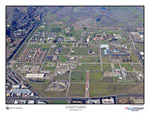May 10, 2011
SunCal Swaps New Army Quarters for Prime Land
By Teresa Burney
Builder
 SunCal swapped the U.S. Army new quarters at the Army Reserves Training Area in Camp Parks, Calif. (shown here), for 180 acres destined to become a master planned community.
SunCal swapped the U.S. Army new quarters at the Army Reserves Training Area in Camp Parks, Calif. (shown here), for 180 acres destined to become a master planned community.
At a time when it’s tough to find cash to buy land, much less enough to build a master planned community in California, SunCal figured out a way to barter for it.
SunCal, the largest private land developer in the country, is building the U.S. Army Reserve new training facilities at Camp Park in Northern California over the next eight years in exchange for 180 acres in Dublin, Calif., slated to become Dublin Crossing, a transit-oriented master planned community with 1,500 new homes as well as parks, shops, offices, hotels, and industrial uses.
“It’s a beautiful piece of property in a fantastic location in an absolutely prime market, even in these challenging times,” Frank Faye, SunCal’s chief operating officer, told Builder.
In the largest ever exchange agreement with the U.S. Army Reserve, SunCal has contracted to build, in six phases over the next eight years, a new main gate for Camp Parks, a 4,300-square-foot administrative building for base police, a 33,000-square-foot area maintenance support facility, a 33,000-square-foot regional medical training facility, a 42,000-square-foot Army Reserve Training facility, a 40,000-square-foot public works/logistics warehouse, and a variety of road and utilities infrastructure, construction, and improvements.
In return, SunCal got 180 acres of formerly Army-owned land in Dublin, located in the San Francisco Bay area. The land already has entitlements and a preliminary land plan.
“This is a very low risk entitlement project,” said Faye. “We are continuing an entitlement project that the city has started rather than starting from ground one.”
The city of Dublin is happy to have SunCal onboard, and is eager to have the land, which is within walking distance of a Bay Area Rapid Transit (BART) station.
“This brings the vision of Dublin Crossing a step closer to reality,” said Dublin Mayor Tim Sbranti in the announcement of the deal. “We’re excited to continue working with SunCal as we partner to bring new jobs, shops, restaurants, and homes, plus parks and trails, to Dublin. This new neighborhood is a significant part of our city’s future.”
The economy will decide when Dublin Crossing gets built, said Faye. “The market will dictate ultimately how fast we are able to move,” he said. “Happily, in this case, we are definitely supply constrained and in a contracted market. The Dublin submarket is where you want to be, I’m pretty darned sure.”
SunCal had plenty of initial competition for the deal. More than 150 investors, contractors, developers, and other parties were interested at the beginning of the Army’s search for a partner some two-plus years ago. But the collapsed housing market actually helped SunCal win it.
“The attrition that has made its way through the land development world” has decimated the ranks of land developers up to the task, said Faye. “We would like to think that we are the only one on the map standing with the fully integrated platform to execute this. We were able to hold our platform together, hold our senior team together, and hold our middle management team together.”
The negotiations took a while because the exchange process is a relatively new one for the military and SunCal, particularly for such a large deal, said Faye.
“When you are kind of blazing a trail things take a little longer than they would ordinarily,” said Faye. “This is a relatively new model for the Army, one I think we together helped to work the bugs out of.”
The Army seemed as happy as SunCal with the deal.
“We’re pleased to reach this important milestone so new base facilities can be built at no added cost to taxpayers,” said Joseph F. Calcara, Deputy Assistant Secretary of the Army in announcing the trade. “This exchange represents the type of innovative public-private partnerships that will enable us to maintain top-rate facilities for our Reserve Forces for many decades to come.”
Teresa Burney is a senior editor for Builder magazine.


